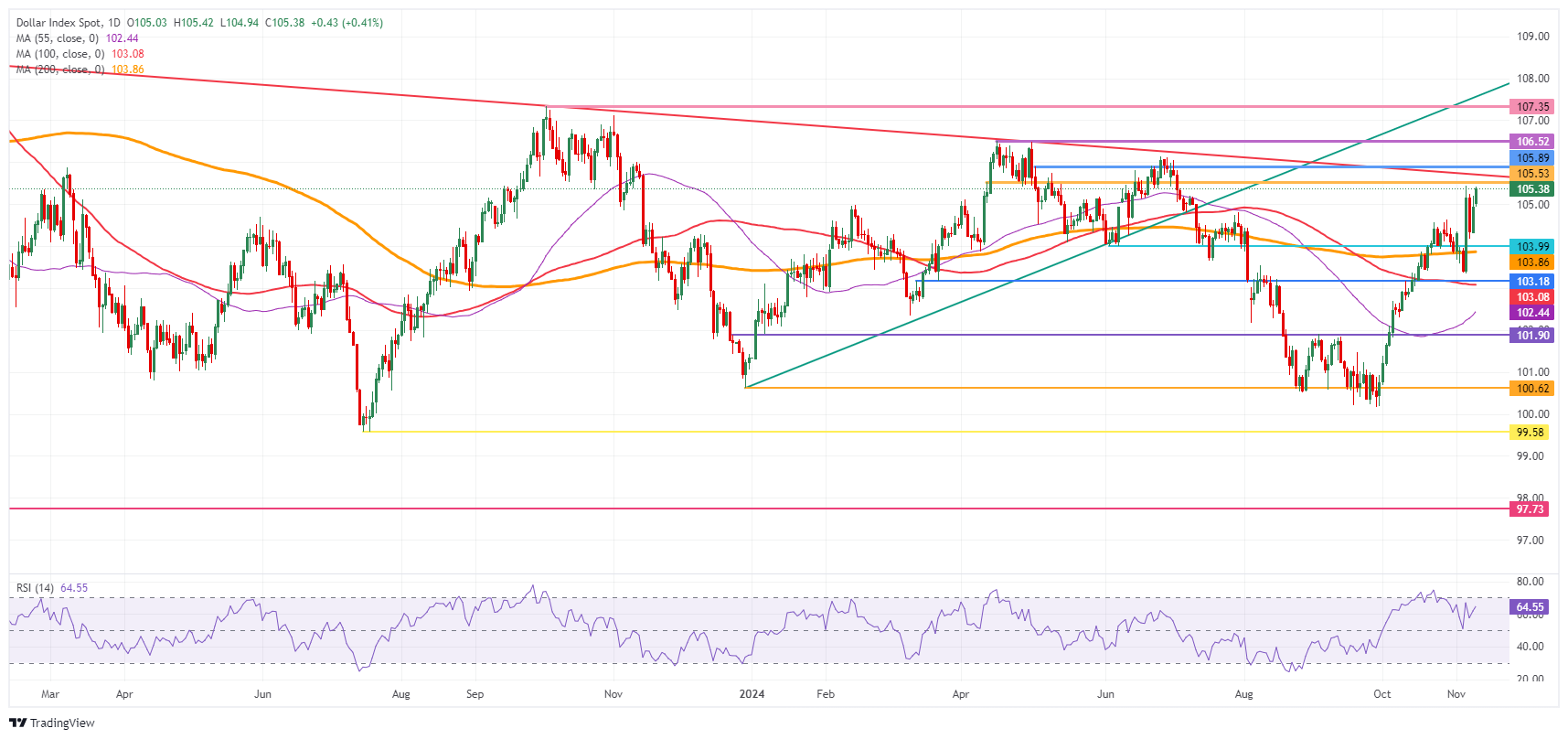US Dollar strengthens near four-month highs with US inflation in focus
- The US Dollar trades in the green across the board on Monday.
- The focus will be on the US inflation data for October later this week.
- The US Dollar index pops above 105.00 and is ready to test resistance levels.
The US Dollar (USD) starts the week on the front foot and strengthens on Monday, with the US Dollar Index (DXY) edging higher above the 105.00 level. The positive undertone for the Greenback is supported by the increasing likelihood that the Republican Party will win a majority in the US Congress after President-elect Donald Trump has already won the presidency and the Republicans secured a majority in the US Senate. The vote count for the House of Representatives is still ongoing, with only four more seats needed for the Republicans to win it.
The US economic calendar is empty on Monday in observance of Veteran's Day. Stock markets in the US will remain open, but bond markets will be closed.
Later in the week, investors will pay close attention to speeches from several Federal Reserve (Fed) officials, including Fed Chair Jerome Powell, and the US Consumer Price Index (CPI) data for October, which will be published on Wednesday.
Daily digest market movers: Off to a positive start
- Due to the Veterans’ Day bank holiday, expect low volatility and volumes as US bond markets remain closed on Monday.
- All equities are off to a good start this week. European equities are surging over 1%, while US equity futures are in positive territory ahead of the opening bell.
- The CME FedWatch Tool is pricing in another 25 basis points (bps) rate cut by the Fed at the December 18 meeting by 68.5%. A smaller 31.5% chance is for rates to remain unchanged.
- The US 10-year benchmark rate trades at 4.30%, and the bond market remains closed on Monday.
US Dollar Index Technical Analysis: Here comes resistance again
The US Dollar Index (DXY) pushes higher on Monday after headlines over the weekend that President-elect Trump has won the last remaining swing state in the US election and has secured a substantial landslide victory. Should the House of Representatives, where counting is still ongoing, fall in the hands of the Republicans, expect another push higher in the DXY once the headline breaks and is confirmed by several media outlets.
The first level to watch out for on the upside is 105.53 (April 11 high), a very firm cap resistance, with 105.89 (May 2 high) just above. Once that level is broken, 106.52, the high of April and a double top, will be the last level standing before starting to talk about 107.00.
On the downside, the round level of 104.00 and the 200-day Simple Moving Average (SMA) at 103.86 should refrain from sending the DXY any lower.

US Dollar Index: Daily Chart
US Dollar FAQs
The US Dollar (USD) is the official currency of the United States of America, and the ‘de facto’ currency of a significant number of other countries where it is found in circulation alongside local notes. It is the most heavily traded currency in the world, accounting for over 88% of all global foreign exchange turnover, or an average of $6.6 trillion in transactions per day, according to data from 2022. Following the second world war, the USD took over from the British Pound as the world’s reserve currency. For most of its history, the US Dollar was backed by Gold, until the Bretton Woods Agreement in 1971 when the Gold Standard went away.
The most important single factor impacting on the value of the US Dollar is monetary policy, which is shaped by the Federal Reserve (Fed). The Fed has two mandates: to achieve price stability (control inflation) and foster full employment. Its primary tool to achieve these two goals is by adjusting interest rates. When prices are rising too quickly and inflation is above the Fed’s 2% target, the Fed will raise rates, which helps the USD value. When inflation falls below 2% or the Unemployment Rate is too high, the Fed may lower interest rates, which weighs on the Greenback.
In extreme situations, the Federal Reserve can also print more Dollars and enact quantitative easing (QE). QE is the process by which the Fed substantially increases the flow of credit in a stuck financial system. It is a non-standard policy measure used when credit has dried up because banks will not lend to each other (out of the fear of counterparty default). It is a last resort when simply lowering interest rates is unlikely to achieve the necessary result. It was the Fed’s weapon of choice to combat the credit crunch that occurred during the Great Financial Crisis in 2008. It involves the Fed printing more Dollars and using them to buy US government bonds predominantly from financial institutions. QE usually leads to a weaker US Dollar.
Quantitative tightening (QT) is the reverse process whereby the Federal Reserve stops buying bonds from financial institutions and does not reinvest the principal from the bonds it holds maturing in new purchases. It is usually positive for the US Dollar.

